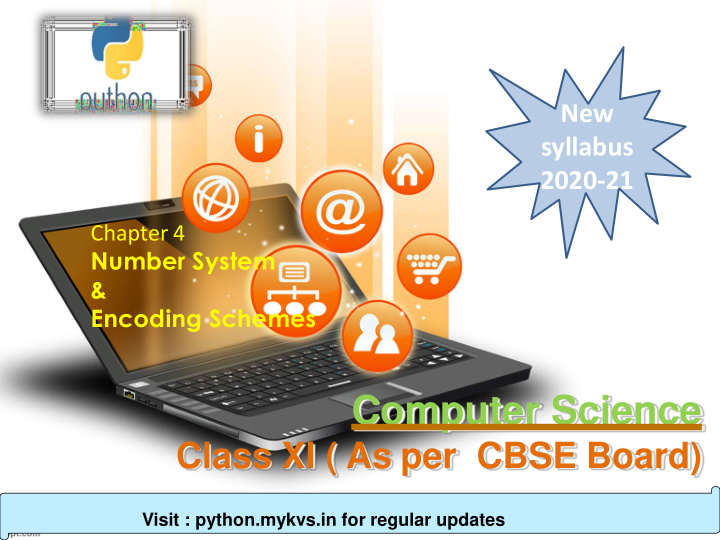



New syllabus 2020-21 Chapter 4 Number System & Encoding Schemes Computer Science Class XI ( As per CBSE Board) Visit : python.mykvs.in for regular updates
Number System In general term computer represent information in different types of data forms i.e. number , character ,picture ,audio , video etc. Computers are made of a series of switches/ gates. Each switch has two states: ON(1) or OFF(0).That's why computer works on the basis of binary number system(0/1).But for different purpose different number systems are used in computer world to represent information. E.g. Octal, Decimal, Hexadecimal. Visit : python.mykvs.in for regular updates
Decimal Number System Characteristics Positional (Most) people use the decimal number system Why? THIS A POSITIONAL NUMBER SYSTEM .and that's of great advantage ..simple shifting the position of decimal.It become complex either case to use number system <10 or >10. Visit : python.mykvs.in for regular updates
Binary Number System Characteristics Positional Most (digital) computers use the binary number system Why? Computers are made of a series of switches/ gates. Each switch has two states: ON(1) or OFF(0).That's why computer works on the basis of binary number system(0/1). Visit : python.mykvs.in for regular updates
Decimal-Binary Equivalence Visit : python.mykvs.in for regular updates
Binary – Decimal Conversion Using positional notation Visit : python.mykvs.in for regular updates
Decimal-Binary Conversion Using the Division Method: Divide decimal number by 2 until you reach zero, and then collect the remainders in reverse. Visit : python.mykvs.in for regular updates
Hexadecimal Number System Characteristics Positional Computer programmers often use the hexadecimal number system,Why? Computers only work on the binary number system. The hexadecimal number system is commonly used to describe locations in computer memory. They are also used in assembly language instructions. Visit : python.mykvs.in for regular updates
Decimal-Hexadecimal Equivalence Visit : python.mykvs.in for regular updates
Hexadecimal to decimal Decimal to hexadecimal Read from bottom to top: 25 16 Visit : python.mykvs.in for regular updates
Binary - hexadecimal Visit : python.mykvs.in for regular updates
Binary to hexadecimal Convert 110100110 2 to hex Starting at the right end, split into groups of 4: (pad empty digits with 0) Visit : python.mykvs.in for regular updates
Hexadecimal to Binary Convert 3D9 16 to binary Convert each hex digit to 4 bits: (can remove leading zeros) Visit : python.mykvs.in for regular updates
Octal Number System Characteristics Positional • Computer programmers often use the octal number system,Why? Octal and hex use the human advantage that they can work with lots of symbols while it is still easily convertible back and forth between binary. Visit : python.mykvs.in for regular updates
Decimal-Octal Equivalence Visit : python.mykvs.in for regular updates
Octal to decimal positional powers of 8: decimal positional value: Octal number: Visit : python.mykvs.in for regular updates
Decimal to octal Using the Division Method: Example 1: Visit : python.mykvs.in for regular updates
Binary-Octal Conversion E.g. Octal to binary Visit : python.mykvs.in for regular updates
Binary addition Start at right column Proceed leftward Carry 1 when necessary Visit : python.mykvs.in for regular updates
Encoding Schemes/ String representation String is any finite sequence of characters.Any string includes etters, numerals, symbols and punctuation marks. Computers are designed to work internally with numbers. In order to handle characters, we need to choose a number for each character. There are many ways to do this ,which are knows as encoding schemes. Visit : python.mykvs.in for regular updates
Encoding schemes Following are some Encoding schemes • ASCII • UNICODE • ISCII Visit : python.mykvs.in for regular updates
Encoding Scheme ASCII It is most common coding system (Pronounced ass-key). ASCII = American National Standard Code for Information Interchange It is Defined in ANSI document X3.4-1977. It is a 7-bit code.Its 8th bit is unused (or used for a parity bit) Two general types of codes: 95 are “Graphic” codes (displayable on a console) 33 are “Control” codes (control features of the console or communications channel) Visit : python.mykvs.in for regular updates
Encoding Scheme ASCII Visit : python.mykvs.in for regular updates
Encoding Scheme ASCII CHART LEAST SIGNIFICANT BIT Visit : python.mykvs.in for regular updates
Encoding Scheme ASCII “Hello, world” Example LEAST SIGNIFICANT BIT Visit : python.mykvs.in for regular updates
Encoding Scheme UNICODE It is a worldwide character-encoding standard .Its main objective is to enable a single, unique character set that is capable of supporting all characters from all scripts, as well as symbols, that are commonly utilized for computer processing throughout the world. Visit : python.mykvs.in for regular updates
Encoding Scheme ISCII ISCII stands for Indian Script Code for Information Interchange for Indian languages. It is an 8-bits code to represent Indian scripts. The Department of Electronics (DOE) has established standard and standard are in action from 1983. These codes are used for 10 Indian scripts- Devanagri, Punjabi, Gujrati, Udia, Bengali, Asami, Telgu, Kannad, Malayalam and Tamil. C-DAC (established in August- September, 1988) developed standard for font coding in 1990 is called ISFOC (Indian Standards for Font Coding). LEAST SIGNIFICANT BIT Visit : python.mykvs.in for regular updates
Recommend
More recommend